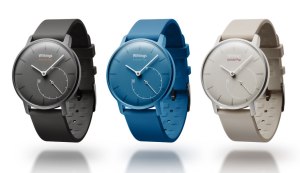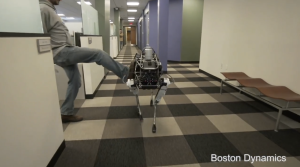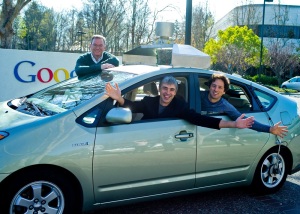The Withings Activité Pop is a fitness tracker for people who don’t want to look like they’re wearing a fitness tracker. On the surface, the Activite Pop looks like a regular analog watch (with an old-school clock face), but the device subtly tracks your activity and sleep. In addition to telling you the time of day, th

The Withings Activité Pop. Credit: Withings
e tracker includes a smaller dial that shows your progress toward your activity goals, from 0 to 100 percent. And when you’re ready to hit the sack, the Pop will automatically detect that you’ve started sleeping (there’s no need to put it in sleep mode, as you have to do with some other trackers). You can set the Pop’s alarm to wake you up.
At around $150, the Pop is a more affordable version of the company’s previous fashion-forward fitness tracker, the Activite, which costs $450. The two devices are similar, but the Pop is made from some different materials: For example, the Pop has a silicone strap, whereas the Activité’s is leather.
Still, the Pop is about the same price as the new Fitbit Charge HR, but unlike that device, the Pop does not track heart rate, nor does it include smartwatch features such as caller ID. But those who want to get away from clunky smartwatches may not miss such features.
Design/Comfort: ★★★☆☆
The Pop comes in three colors — Azure, Shark Grey and Sand — and additional wristband colors will be available soon, the company says. You can also use your own watch straps, if you wish, because the Pop has standard watch attachments.
One thing that disappointed me is that the Pop did not quite fit my wrist; even after I adjusted the strap to the smallest size, the device was slightly too big, so that it slid around on my wrist while I was wearing it. This probably would not be a problem for most people, but those with smaller-than-average wrists should be aware that this device (and the accompanying straps) may not quite fit them.
Because the tracker does not have a digital screen, you can’t see the exact count of your steps taken or calories burned on the watch itself — for that, you’ll need to download the Withings Health Mate app, and sync the watch with your smartphone via Bluetooth. (Currently, the Pop only syncs with the iPhone, but Android compatibility is coming at the end of February.)
There aren’t any buttons on the Pop, either, so you also set the alarm, and calibrate the device hands, through the app. If you tap the watch face, the hands of the watch will move to show you the time of your alarm, although I found this feature pretty useless (since I knew what time I’d set my alarm for). During the week I wore the Pop, I sometimes wished the device was a bit more interactive. But again, the Pop is supposed to be a wearable that’s disguised as a regular watch, so it’s not aiming to be a device that’s full of bells and whistles.
You won’t need to charge the Pop; it comes with a watch battery that lasts at least eight months, according to the company.
User Friendliness: ★★★☆☆
I found the process of syncing the Pop with the Health Mate app to be fairly straightforward. However, the method for setting the alarm is a bit odd. The app presents you with an alarm time (around 7 a.m.), and then you slide your finger up or down your phone’s screen to change the time. But you can’t choose the hours and minutes separately. So if you wanted to set your alarm for some time in the afternoon, you would have to slide your finger down the screen, and keep sliding — going minute by minute — until you eventually reached the time you wanted. This takes quite a while. I’m guessing that Withings assumes that most people are using the alarm feature to choose a wakeup time in the morning.
The Withings app has undergone a redesign since I last used it (to review the company’s Pulse O2 tracker), and I like the new presentation. The app now shows your activity at the top, and then a timeline of your various activities throughout the week as you scroll down. (The new design actually reminded me of theJawbone Up app.) If you choose a specific day, you can see exactly how active you were at any point during that day, as well as your overall steps, distance, calories burned and elevation(vertical distance climbed), and how close you got to reaching your goals. You can also see your weekly averages for metrics like steps taken and hours spent sleeping.
Devices like the Pop, which track sleep without needing to be put into sleep mode, are decidedly more convenient than those that do need to be put into sleep mode, in my experience. I also found that this device was pretty accurate at detecting when I was awake versus asleep. In fact, I was impressed that the device could tell the difference between when I was just sitting quietly and when I was actually asleep.
The alarm vibrates quite a few times to wake you up. But if you like to hit snooze, you’re out of luck — the Pop’s alarm does not have a snooze feature. If you forget to wear your Pop to bed, the alarm won’t go off.
The default activity goal on the Pop is 10,000 steps per day, but I couldn’t change my step goal. I found this a bit annoying, especially because you can’t see your actual step count by looking at the device, only the percentage of your step goal you’ve achieved. But the company told me that an update in late February will allow users to set their own goals (if they want to choose something other than 10,000 steps).
Value of Information: ★★★☆☆
Unlike a lot of other fitness trackers, the Pop (like other Withings devices) does actually include some information about what your stats mean. However, this information is somewhat buried in the Health Mate app. For example, if you select a day’s activity and look at your sleep, you’ll see three small dots in the upper right-hand corner of the screen. Tap on the dots, and you’ll be given the option to view the Help Center. Within this center, Withings provides answers to various questions that actually might be helpful to people who want to not just track but also improve their health. Answered questions include “How much physical activity should I get?”, “What are the consequences of physical inactivity?” and “How can I improve my sleep quality?” All this information is very useful, but I wish it were featured more prominently within the app.
On the downside, the app offers no explanation as to why 10,000 steps is the default step goal. Many fitness trackers similarly pick this default goal, even though it is not an official health recommendation. (In fact, to meet physical activity guidelines, you’d probably only need to walk about 7,000 to 8,000 steps a day, experts say.)
And because the Pop’s hand dial shows you your progress as a percentage, the dial will move only a small amount when you’ve walked a few thousands steps. Some people may find this disheartening (I know I did). I’m a pretty active person, and I never reached the 10,000-step goal per day while I wore the device.
Enjoyment/Inspiration: ★★★☆☆
If you enjoy earning rewards, you may like that the Withings app sends push notifications to your smartphone for certain accomplishments — such as when you’ve unlocked a badge (which might tell you that you’ve walked enough to have climbed the Eiffel Tower, for example). The app also sends you reminders when you forget to wear your Pop.
About once or twice a week, the Health Mate app provides users with an analysis of their activity — in the form of a short message — which the app calls Insights. The only message that I received during my week of testing was one that read, “With only 6,420 steps, that was the least active you’ve been in 15 days,” along with an accompanying frowny face. Needless to say, I did not find this very motivating. I love the idea of providing users with insights that get more specific the more you use a device, but telling someone that they’re not doing well may actually backfire.
The app does have a feature called Reminders, which allows you to set memory-jogging messages to yourself to engage in healthy behaviors, such as weighing yourself or going for a run every day. These reminders appear as notifications on your phone.
The app also has a feature called Leaderboard, which allows you to challenge your friends to a weekly step competition to see who can walk the most. This type of competition may motivate some people: Withings says that those who use the Leaderboard feature are 24 percent more active, on average, than other Withings users.
Conclusion: 12 out of 20 stars
If you’re looking for a fitness tracker that’s stylish and doesn’t scream “tech geek,” the Pop might be right for you. It subtly tracks your activity and sleep, without a whole lot of bells and whistles. Other pluses are that the device has automatic sleep detection and can be worn swimming.



